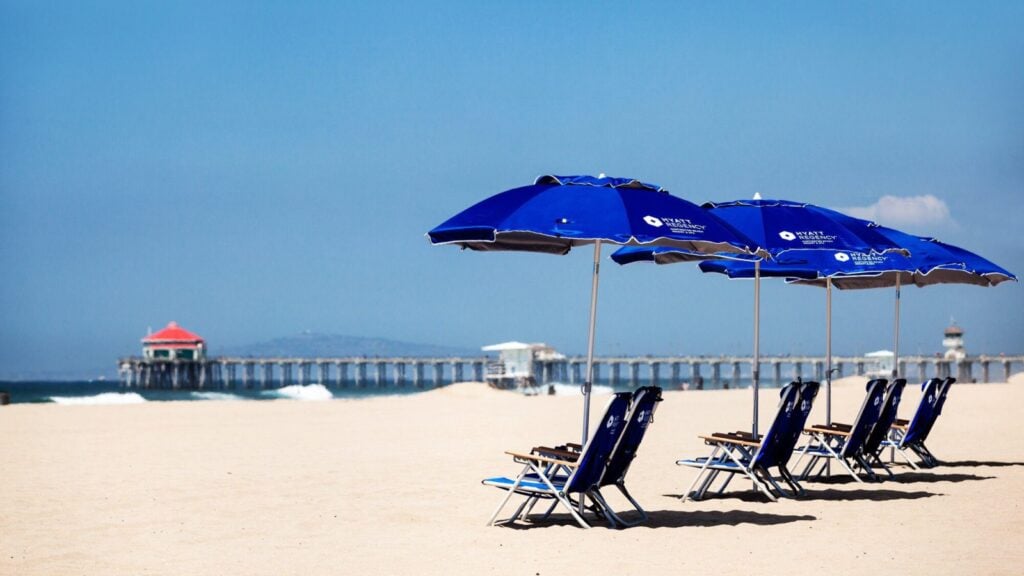Many family vacations are centered around spending time in the sun, so one of the most important items you should have in your luggage, carry-on, backpack, or beach bag is sunscreen.
“We know that sunscreen protects the skin against skin cancer when it’s used properly,” says Dr. Alexandra Cvijanovich, MD, FAAP, a pediatrician in Albuquerque and spokesperson for the American Academy of Pediatrics. “Skin cancer can be deadly, so this is an easy, cheap, and painless way to protect our skin against skin cancer.”
If you need a refresher on sunscreen 101 or your teen has been influenced by some of the sunscreen misinformation being spread on TikTok, we’ve got you covered. Read on for expert tips and advice on how to keep the whole family protected.
BUDGET-FRIENDLY: 13 cheap family vacations that are super fun
Why is sunscreen important?

“We know that sun protection, which includes sunscreen and sun-protective clothing, hats, and things like that, is the single most-impactful thing you can do starting in your youth to protect yourself from skin cancers,” says Dr. Mary P. Lupo, MD, a New Orleans–based dermatologist. That includes less dangerous forms of skin cancer like basal cell carcinoma and more harmful cancers like melanoma.
KID-FRIENDLY: 19 best family resorts and hotels in the U.S.
“Protection also will pay off as you get older, because sun-induced aging is one of the most obvious and preventable ways in which the skin ages,” adds Dr. Lupo. So if your teen has a multistep skincare routine that’s been influenced by TikTok but is giving you grief about wearing sunscreen, this is a good point to mention.
How does sunscreen work?

There are two basic types of sunscreen: physical and chemical. Physical sunscreens (also known as organic and mineral sunscreens) sit on the surface of the skin and reflect the sun’s rays like a shield. Chemical sunscreens absorb UV rays so they don’t reach the skin.
CHECKING IN: The 12 best family-friendly hotels and resorts in Southwest Florida
Both types are effective and often come down to a matter of personal choice. For chemical sunscreens, look for options that don’t contain oxybenzone, but either kind will do the job. And if your teen tries to tell you that sunscreen is toxic based on something they saw on social media, medical experts can quickly debunk that.
“Chemical and physical sunscreens have been around now for decades and are proven by the FDA and tested by the FDA to be safe,” says Dr. Lupo. “We have no data after all these years to suggest that there’s anything toxic about any of the sunscreens currently available in the U.S.”
Exposure to UV rays without any kind of sun protection is actually way more dangerous. “There is no such thing as a safe tan or a healthy tan,” says Dr. Dawn Davis, MD, a pediatric dermatologist and professor of dermatology and pediatrics at the Mayo Clinic. “Getting exposure to sun that leads to redness or coloring of the skin in any way that’s not your baseline natural skin tone is indication that there is damage.”
What sunscreen is best for my family?

Start off by choosing a sunscreen that offers broad-spectrum protection from UVA and UVB rays and has an SPF between 30 and 50. After that, it comes down to personal preference. The best sunscreen for your family is the one you’ll actually use.
“It’s definitely important to like your sunscreen,” says Dr. Lupo. “I expect you to use sunscreen, so you better find one you like.” (Check our recommendations for the best sunscreens for babies and toddlers and sunscreens for the whole family for some good options.)
MAKE MEMORIES: 25 best family vacation spots in the U.S. for all ages
Mineral-based sunscreens with ingredients like zinc or titanium oxide can be good choices for young kids because they’re gentler on the skin. But some people can find those heavy and chalky. In that case, a gel sunscreen (like cult favorite Supergoop Unseen Sunscreen or e.l.f. SKIN Suntouchable Invisible Sunscreen) can be a good option.
“You can feel those going on, but within several seconds it feels as if it evaporates off the skin, so it doesn’t feel heavy,” says Dr. Davis. “For people who don’t want to feel sticky or like they’re covered in lotion, using an alcohol-based sunscreen can be very helpful.”

Powdered sunscreens can be useful for touchups when you’re on the go, and spray sunscreens can be super convenient for covering large areas quickly. For sprays, make sure you don’t inhale it as you’re applying, rub it in after spraying it on, and be generous with your application.
“It’s not like you’re misting or putting on perfume,” says Dr. Davis. “It should be a liquid cover. Most people underutilize spray sunscreen.” She recommends thinking of it like spray painting a piece of furniture. “It should be thicker than people think of,” she says.
When and how should I apply sunscreen?

Don’t wait until you’re at the beach, pool, or lake to slather up. “You want to put sunscreen on 15 to 30 minutes before going outside,” says Dr. Cvijanovich. And don’t skip it if it’s a cloudy day.
“People need to put on sunscreen even if it’s not sunny,” she says. “UV rays can certainly go through clouds. Those tend to be almost the most dangerous days, because we forget when we’re outside and it’s cloudy. And then we end up with a sunburn.”
SET SAIL: 12 best family cruises and ships in the world
Make sure you’re putting enough sunscreen on: Keep the classic “shot glass full” of sunscreen tip in mind. “Studies show that patients don’t use enough sunscreen; they only apply about one third of what is recommended,” says Dr. Davis. “If you’re only applying one third of what is recommended, you’re not getting the equivalent SPF of what is on the bottle.”
Reapply every two hours or after going in the water, because no sunscreen is truly waterproof. And up your protection level by wearing a hat and sunglasses and spending some time under an umbrella or in the shade. “Those little things you can do will make sunscreen work better because you’re not abusing its life expectancy,” says Dr. Lupo.

For little ones, make the application process fun by offering some kind of reward or distraction like a song you always play for sunscreen time. “For my own children I had a silly song and silly dance I would participate in at the same time,” says Dr. Davis. “It became kind of funny because mom looked silly.”
Make wearing sunscreen something of a ritual and routine and your kids will be more apt to go along with it and keep wearing it as they get older. “Try to start the sunscreen use when they’re so young that they don’t know any difference,” says Dr. Lupo. “Normalize the use of sunscreen so that your child couldn’t imagine being outside without sunscreen on.”
More from FamilyVacationist:
- 50 best family vacation ideas for all ages
- 10 dreamy Florida beach resorts that are perfect for families
- The 10 most beautiful Caribbean beaches (and where to stay near each)












